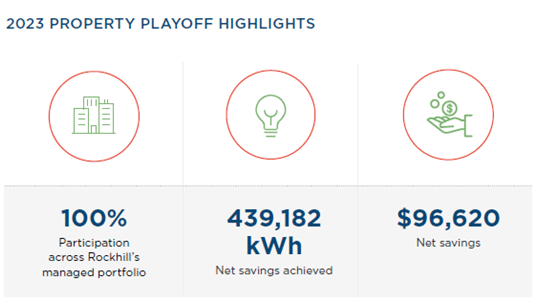Tenant engagement in decarbonization efforts is pivotal. By engaging tenants in the decarbonization journey, landlords can:
-
- Guide energy consumption reduction: Depending on the building type, the building’s occupants can control up to 80% of energy use in a commercial building. By encouraging energy-efficient practices, landlords can guide tenants to substantial reductions in carbon emissions.
- Influence behavioral change: Awareness and education empower tenants to adopt greener habits such as energy-efficient lighting usage, responsible heating and cooling practices, and reducing water consumption.
- Amplify sustainable impact: Collective efforts amplify the impact of individual actions. By fostering a community committed to sustainability, tenants and landlords can motivate each other and share best practices. Tenants and landlords both likely have their own goals and regulations to follow, which necessitates a collaborative approach.
Read Part 1 of our tenant engagement series to learn building-focused tenant engagement strategies to help landlords and tenants work collaboratively towards a shared goal of reducing carbon emissions and enhancing overall energy efficiency. In this Part 2, we delve into 3 people-focused tenant engagement strategies.
#1: RUN EDUCATION AND AWARENESS CAMPAIGNS
By educating building occupants about the environmental impact of their actions and raising awareness about energy-efficient practices, such campaigns empower individuals to make informed decisions that can reduce carbon emissions. Through workshops, seminars, and informational materials, tenants can gain insights into the benefits of energy conservation, renewable energy adoption, and sustainable building practices. These initiatives not only encourage behavioral changes but also cultivate a shared commitment to environmental stewardship, laying the groundwork for collective action towards a greener, more sustainable future for commercial buildings and the broader community.
Spotlight: Property Playoffs at Rockhill Management
Rockhill Management, a dedicated property services affiliate of Rockpoint that serves commercial and residential properties in the U.S., developed and launched its Property Playoffs energy reduction competition between its office property teams to create awareness for its energy management program. Rockhill uses this annual competition to create momentum and energize employees to achieve energy reduction goals.
As part of the efforts, property managers are encouraged to reach out to their tenants to share ENERGY STAR tools and resources aimed at reducing energy consumption and how they can get involved in the Property Playoffs. A few highlights from this year’s Property Playoffs include:
-
- Rockhill provided decarbonization training to employees and tenants during Earth Week celebrations. This workshop was designed to equip participants with essential insights and strategies to tackle the challenges specific to the building typologies within Rockhill’s portfolio.
- Tenants were encouraged to participate in the ENERGY STAR® Tenant Space Program.
- Rockhill’s property managers shared buildings’ energy use with tenants and provided feedback sessions with individual tenants.
- Rockhill created an Energy Management Guide to showcase the Property Playoffs, a leaderboard, Tenant Tips for energy reduction, and a glossary of terms.
- Rockhill property teams and tenants collaborated on procedural adjustments within operations teams for energy savings. For example: shut down systems 30 minutes early every day.
- Rockhill property teams held events to encourage tenants to carpool and/or take public transportation as well as turn off lights and/or equipment when not in use.
#2: IMPLEMENT GREEN LEASES
Typical leases tend to create a split incentive between building owners and tenants: one party bears the cost of investing in energy and water efficiency improvements, while the other enjoys the benefits of reduced utility costs from those upgrades. Incentivizing sustainable behavior through green leases, also known as “high performance” or “energy-aligned” leases, is a powerful strategy in advancing the decarbonization agenda within commercial buildings. Green lease provisions align the financial and energy incentives of building owners and tenants, fostering collaboration to achieve cost savings, resource conservation, efficient building operations, and continuous building improvements.
Green lease provisions can cover a range of sustainability initiatives, such as energy efficiency upgrades, lighting retrofits, and comprehensive building recycling and composting programs. They often include guidelines for sustainable procurement, the sharing of utility data, sub-metering, and minimum fit-out standards. Incorporating sustainable design elements into the lease can provide many benefits, such as increased tenant comfort and energy savings. Additionally, green leases may encourage the use of renewable energy sources and water-saving technologies.
The Green Lease Leaders recognition program, developed by Institute for Market Transformation (IMT) with support from the U.S. Department of Energy’s Better Buildings Alliance, establishes national standards for green leases and recognizes leaders who are using green lease provisions as a tool to achieve high-performance buildings with energy and resource savings. It also offers a green lease library, providing landlords and tenants with best practices, tools, and models to foster collaboration and ensure their buildings are energy-aligned.
#3: ESTABLISH PROCESSES AND SYSTEMS TO FOSTER COLLABORATION
Transparent processes and systems are crucial to the success of an actionable decarbonization plan. This can start with something as straightforward as ensuring that landlords and tenants each designate a sustainability contact person within their organizations. Having a dedicated resource for addressing energy or sustainability questions is a key first step in effectively communicating potential projects and operational details. All systems and processes for collaboration should be detailed in the green lease, noting roles and responsibilities of both the landlord and tenant.
In addition to lease clauses and transparency, it’s important to provide tools and awareness to address the technical challenges of tracking progress and verifying that the space is operating as intended. As we noted in Part 1 of this series, landlords and tenants can utilize platforms such as ENERGY STAR Portfolio Manager to facilitate sharing data in an organized way. Formal processes such as instructions for sharing, monitoring, and quality controls should be documented and available to all tenants. Policies and guidelines are an important element for optimizing decarbonization collaboration between tenants and landlords. Sustainable design and construction guidelines can prioritize sustainable materials, methods, and models that can help achieve decarbonization goals.
READY TO ENGAGE?
Tenant engagement is a cornerstone of successful decarbonization efforts. By reducing energy consumption, influencing behavioral change, and fostering collaboration, tenants and landlords can work together to create a more sustainable built environment. Engaging tenants through education, awareness campaigns, and initiatives like Rockhill Management’s Property Playoffs not only drives energy efficiency but also builds a community committed to environmental stewardship. Implementing green leases further aligns the interests of both parties, ensuring that sustainability goals are met collectively.
Transparency and clear communication play essential roles in these collaborations. Designating sustainability contacts, establishing formal processes, and using tools to track and verify progress helps both parties work efficiently towards common objectives. With these measures in place, landlords and tenants can work together to not only meet but exceed decarbonization goals, creating healthier, more sustainable commercial buildings and communities.
Reach out to our team to discuss how to decarbonize now by collaborating with your tenants.




